The Spatiotemporal Variation Characteristics and Influencing Factors of Green Vegetation in China
Abstract
1. Introduction
2. Methods and Materials
2.1. Research Methods
2.1.1. Vegetation Growth and Contraction Index
2.1.2. Vegetation Change Nuclear Density
2.1.3. Vegetation Change Standard Deviation Ellipse
2.1.4. Multiple Linear Regression Model
2.2. Data Collection
3. Result Analysis
3.1. Analysis of Total Shrinkage and Growth of Urban Vegetation
3.2. Analysis of Spatial Evolution Characteristics of Urban Vegetation Shrinkage and Growth
3.3. Analysis of Shrinkage and Growth Trends for Urban Vegetation
4. Analysis of the Influencing Factors
5. Strategic Recommendations
5.1. Differential Repair of Macro-Strategy Dimension
5.2. Differential Repair of Spatial Dimensions
5.3. Differential Restoration of Vegetation Type Dimension
5.4. Differentiated Repair of Administrative and Market Dimensions
6. Conclusions
Author Contributions
Funding
Institutional Review Board Statement
Informed Consent Statement
Data Availability Statement
Conflicts of Interest
References
- Li, D.; Wu, S.; Liang, Z.; Li, S. The impacts of urbanization and climate change on urban vegetation dynamics in China. Urban For. Urban Green. 2020, 54, 126764. [Google Scholar] [CrossRef]
- Piao, S.; Yin, G.; Tan, J.; Cheng, L.; Huang, M.; Li, Y.; Liu, R.; Mao, J.; Myneni, R.B.; Peng, S.; et al. Detection and attribution of vegetation greening trend in China over the last 30 years. Glob. Change Biol. 2015, 21, 1601–1609. [Google Scholar] [CrossRef]
- Lu, F.; Hu, H.; Sun, W.; Zhu, J.; Liu, G.; Zhou, W.; Zhang, Q.; Shi, P.; Liu, X.; Wu, X.; et al. Effects of national ecological restoration projects on carbon sequestration in China from 2001 to 2010. Proc. Natl. Acad. Sci. USA 2018, 115, 4039–4044. Available online: https://www.pnas.org/doi/abs/10.1073/pnas.1700294115 (accessed on 1 May 2023). [CrossRef]
- Wang, J.; Chen, Y.; Shao, X.; Zhang, Y.; Cao, Y. Land-use changes and policy dimension driving forces in China: Present, trend and future. Land Use Policy 2012, 29, 737–749. [Google Scholar] [CrossRef]
- Sieghardt, M.; Mursch-Radlgruber, E.; Paoletti, E.; Couenberg, E.; Dimitrakopoulus, A.; Rego, F.; Hatzistathis, A.; Randrup, T.B. The abiotic urban environment: Impact of urban growing conditions on urban vegetation. Urban For. Trees A Ref. Book 2005, 11, 281–323. Available online: https://springer.dosf.top/chapter/10.1007/3-540-27684-X_12 (accessed on 2 May 2023).
- D’Odorico, P.; Bhattachan, A.; Davis, K.F.; Ravi, S.; Runyan, C.W. Global desertification: Drivers and feedbacks. Adv. Water Resour. 2013, 51, 326–344. Available online: https://www.sciencedirect.com/science/article/pii/S0309170812000231 (accessed on 2 May 2023). [CrossRef]
- Qu, S.; Wang, L.; Lin, A.; Yu, D.; Yuan, M. Distinguishing the impacts of climate change and anthropogenic factors on vegetation dynamics in the Yangtze River Basin, China. Ecol. Indic. 2020, 108, 105724. Available online: https://www.sciencedirect.com/science/article/pii/S1470160X19307174 (accessed on 2 May 2023). [CrossRef]
- Stephenson, N.L. Climatic control of vegetation distribution: The role of the water balance. Am. Nat. 1990, 135, 649–670. [Google Scholar] [CrossRef]
- Pettorelli, N.; Ryan, S.; Mueller, T.; Bunnefeld, N.; Jędrzejewska, B.; Lima, M.; Kausrud, K. The Normalized Difference Vegetation Index (NDVI): Unforeseen successes in animal ecology. Clim. Res. 2011, 46, 15–27. [Google Scholar] [CrossRef]
- Cihlar, J.; Laurent, L.S.; Dyer, J.A. Relation between the normalized difference vegetation index and ecological variables. Remote Sens. Environ. 1991, 35, 279–298. Available online: https://www.sciencedirect.com/science/article/pii/0034425791900182 (accessed on 2 May 2023). [CrossRef]
- Pettorelli, N.; Vik, J.O.; Mysterud, A.; Gaillard, J.M.; Tucker, C.J.; Stenseth, N.C. Using the satellite-derived NDVI to assess ecological responses to environmental change. Trends Ecol. Evol. 2005, 20, 503–510. Available online: https://www.cell.com/trends/ecology-evolution/abstract/S0169-5347(05)00162-X (accessed on 2 May 2023). [CrossRef] [PubMed]
- Tucker, C.J. Red and photographic infrared linear combinations for monitoring vegetation. Remote Sens. Environ. 1979, 8, 127–150. Available online: https://www.sciencedirect.com/science/article/pii/0034425779900130 (accessed on 2 May 2023). [CrossRef]
- Stow, D.A.; Hope, A.; McGuire, D.; Verbyla, D.; Gamon, J.; Huemmrich, F.; Houston, S.; Racine, C.; Sturm, M.; Tape, K.; et al. Remote sensing of vegetation and land-cover change in Arctic Tundra Ecosystems. Remote Sens. Environ. 2004, 89, 281–308. Available online: https://www.sciencedirect.com/science/article/pii/S0034425703002803 (accessed on 3 May 2023). [CrossRef]
- Dirnböck, T.; Dullinger, S.; Grabherr, G. A regional impact assessment of climate and lande in Arctic Tundra Ecosystems. Remote Sens. Environ. 2004, 89, 281–308. Available online: https://www.sciencedirect.com/science/article (accessed on 3 May 2023).
- Sun, W.; Song, X.; Mu, X.; Gao, P.; Wang, F.; Zhao, G. Spatiotemporal vegetation cover variations associated with climate change and ecological restoration in the Loess Plateau. Agric. For. Meteorol. 2015, 209, 87–99. Available online: https://www.sciencedirect.com/science/article/pii/S0168192315001446 (accessed on 3 May 2023). [CrossRef]
- Tucker, C.J.; Townshend, G., Jr.; Goff, T.E. African land-cover classification using satellite data. Science 1985, 227, 369–375. [Google Scholar] [CrossRef] [PubMed]
- Tucker, C.J.; Newcomb, W.W.; Los, S.O.; Prince, S.D. Mean and inter-year variation of growing-season normalized difference vegetation index for the Sahel 1981–1989. Int. J. Remote Sens. 1991, 12, 1133–1135. [Google Scholar] [CrossRef]
- Yang, L.; Wylie, B.K.; Tieszen, L.L.; Reed, B.C. An analysis of relationships among climate forcing and time-integrated NDVI of grasslands over the US northern and central Great Plains. Remote Sens. Environ. 1998, 65, 25–37. [Google Scholar] [CrossRef]
- Weiss, J.L.; Gutzler, D.S.; Coonrod, J.E.; Dahm, C.N. Long-term vegetation monitoring with NDVI in a diverse semi-arid setting, central New Mexico, USA. J. Arid. Environ. 2004, 58, 249–272. [Google Scholar] [CrossRef]
- Song, Y.; Ma, M.; Veroustraete, F. Comparison and conversion of AVHRR GIMMS and SPOT VEGETATION NDVI data in China. Int. J. Remote Sens. 2010, 31, 2377–2392. [Google Scholar] [CrossRef]
- Jin, X.M.; Guo, R.H.; Zhang, Q.; Zhou, Y.X.; Zhang, D.R.; Yang, Z. Response of vegetation pattern to different landform and water-table depth in Hailiutu river basin, northwestern China. Environ. Earth Sci. 2014, 71, 4889–4898. [Google Scholar] [CrossRef]
- Tong, S.; Zhang, J.; Bao, Y.; Lai, Q.; Lian, X.; Li, N.; Bao, Y. Analyzing vegetation dynamic trend on the Mongolian Plateau based on the Hurst exponent and influencing factors from 1982–2013. J. Geogr. Sci. 2018, 28, 595–610. [Google Scholar] [CrossRef]
- Monteleone, B.; Borzí, I.; Arosio, M.; Cesarini, L.; Bonaccorso, B.; Martina, M. Modelling the response of wheat yield to stage-specific water stress in the Po Plain. Agric. Water Manag. 2023, 287, 108444. Available online: https://www.sciencedirect.com/science/article/pii/S0378377423003098 (accessed on 3 May 2023). [CrossRef]
- Moradi, E.; Darabi, H.; Alamdarloo, E.H.; Karimi, M.; Kløve, B. Vegetation vulnerability to hydrometeorological stresses in water-scarce areas using machine learning and remote sensing techniques. Ecol. Inform. 2023, 73, 101838. Available online: https://www.sciencedirect.com/science/article/pii/S1574954122002886 (accessed on 3 May 2023). [CrossRef]
- Hatfield, J.L.; Prueger, J.H. Temperature extremes: Effect on plant growth and development. Weather. Clim. Extrem. 2015, 10, 4–10. Available online: https://www.sciencedirect.com/science/article/pii/S2212094715300116 (accessed on 3 May 2023). [CrossRef]
- Richardson, A.D.; Keenan, T.F.; Migliavacca, M.; Ryu, Y.; Sonnentag, O.; Toomey, M. Climate change, phenology, and phenological control of vegetation feedbacks to the climate system. Agric. For. Meteorol. 2013, 169, 156–173. Available online: https://www.sciencedirect.com/science/article/pii/S0168192312002869 (accessed on 3 May 2023). [CrossRef]
- Li, H.; Liu, L.; Liu, X.; Li, X.; Xu, Z. Greening implication inferred from vegetation dynamics interacted with climate change and human activities over the Southeast Qinghai–Tibet Plateau. Remote Sens. 2019, 11, 2421. [Google Scholar] [CrossRef]
- Li, H.R.; Ma, S.; Zhang, M.; Yin, Y.K.; Wang, L.J.; Jiang, J. Determinants of ecological functional zones in the Qinghai-Tibet Plateau ecological shelter at different scales in 2000 and 2015: From the perspective of ecosystem service bundles. Ecol. Indic. 2023, 154, 110743. Available online: https://www.sciencedirect.com/science/article/pii/S1470160X23008853 (accessed on 3 May 2023). [CrossRef]
- Wu, J.; Loucks, O.L. From balance of nature to hierarchical patch dynamics: A paradigm shift in ecology. Q. Rev. Biol. 1995, 70, 439–466. [Google Scholar] [CrossRef]
- Weltzin, J.F.; Loik, M.E.; Schwinning, S.; Williams, D.G.; Fay, P.A.; Haddad, B.M.; Harte, J.; Huxman, T.E.; Knapp, A.K.; Lin, G.; et al. Assessing the response of terrestrial ecosystems to potential changes in precipitation. Bioscience 2003, 53, 941–952. [Google Scholar] [CrossRef]
- Jiang, L.; Bao, A.; Guo, H.; Ndayisaba, F. Vegetation dynamics and responses to climate change and human activities in Central Asia. Sci. Total Environ. 2017, 599, 967–980. Available online: https://www.sciencedirect.com/science/article/pii/S0048969717311087 (accessed on 4 May 2023). [CrossRef] [PubMed]
- Ge, W.; Deng, L.; Wang, F.; Han, J. Quantifying the contributions of human activities and climate change to vegetation net primary productivity dynamics in China from 2001 to 2016. Sci. Total Environ. 2021, 773, 145648. Available online: https://www.sciencedirect.com/science/article/pii/S0048969721007166 (accessed on 4 May 2023). [CrossRef] [PubMed]
- Li, J.; Song, C.; Cao, L.; Zhu, F.; Meng, X.; Wu, J. Impacts of landscape structure on surface urban heat islands: A case study of Shanghai, China. Remote Sens. Environ. 2011, 115, 3249–3263. Available online: https://www.sciencedirect.com/science/article/pii/S0034425711002525 (accessed on 4 May 2023). [CrossRef]
- Weng, Q. Remote sensing of impervious surfaces in the urban areas: Requirements, methods, and trends. Remote Sens. Environ. 2012, 117, 34–49. Available online: https://www.sciencedirect.com/science/article/pii/S0034425711002811 (accessed on 4 May 2023). [CrossRef]
- Aronson, M.F.; La Sorte, F.A.; Nilon, C.H.; Katti, M.; Goddard, M.A.; Lepczyk, C.A.; Warren, P.S.; Williams, N.S.; Cilliers, S.; Clarkson, B.; et al. A global analysis of the impacts of urbanization on bird and plant diversity reveals key anthropogenic drivers. Proc. R. Soc. B Biol. Sci. 2014, 281, 20133330. [Google Scholar] [CrossRef] [PubMed]
- McNeill, J.R.; Engelke, P. The Great Acceleration: An Environmental History of the Anthropocene Since 1945; Harvard University Press: Boston, MA, USA, 2016. [Google Scholar]
- Zhou, X.; Wang, Y.C. Spatial–temporal dynamics of urban green space in response to rapid urbanization and greening policies. Landsc. Urban Plan. 2011, 100, 268–277. Available online: https://www.sciencedirect.com/science/article/pii/S0169204611000223 (accessed on 4 May 2023). [CrossRef]
- Long, H.; Liu, Y.; Hou, X.; Li, T.; Li, Y. Effects of land use transitions due to rapid urbanization on ecosystem services: Implications for urban planning in the new develo** area of China. Habitat Int. 2014, 44, 536–544. Available online: https://www.sciencedirect.com/science/article/pii/S0197397514001490 (accessed on 4 May 2023). [CrossRef]
- Konrad, C.P.; Booth, D.B. Hydrologic changes in urban streams and their ecological significance. Am. Fish. Soc. Symp. 2005, 47, 17. Available online: https://www.academia.edu/download/37039485/Konrad_and_Booth_2005.pdf (accessed on 4 May 2023).
- Vicente-Serrano, S.M.; Camarero, J.J.; Olano, J.M.; Martín-Hernández, N.; Peña-Gallardo, M.; Tomás-Burguera, M.; Gazol, A.; Azorin-Molina, C.; Bhuyan, U.; El Kenawy, A. Diverse relationships between forest growth and the Normalized Difference Vegetation Index at a global scale. Remote Sens. Environ. 2016, 187, 14–29. Available online: https://www.sciencedirect.com/science/article/pii/S003442571630373X (accessed on 4 May 2023). [CrossRef]
- Berner, L.T.; Beck, P.S.; Bunn, A.G.; Lloyd, A.H.; Goetz, S.J. High-latitude tree growth and satellite vegetation indices: Correlations and trends in Russia and Canada (1982–2008). J. Geophys. Res. Biogeosci. 2011, 116, 1–13. [Google Scholar] [CrossRef]
- Ericson, T. The statistical model and nuclear level densities. Adv. Phys. 1960, 9, 425–511. [Google Scholar] [CrossRef]
- Castenholz, R.W. Thermophilic blue-green algae and the thermal environment. Bacteriol. Rev. 1969, 33, 476–504. Available online: https://journals.asm.org/doi/pdf/10.1128/br.33.4.476-504.1969 (accessed on 4 May 2023). [CrossRef] [PubMed]
- Scott, L.M.; Janikas, M.V. Spatial Statistics in ArcGIS[M]//Handbook of Applied Spatial Analysis: Software Tools, Methods and Applications; Springer: Berlin/Heidelberg, Germany, 2009; pp. 27–41. Available online: https://springer.dosf.top/chapter/10.1007/978-3-642-03647-7_2 (accessed on 4 May 2023).
- Harding, D.J.; Carabajal, C.C. ICESat waveform measurements of within-footprint topographic relief and vegetation vertical structure. Geophys. Res. Lett. 2005, 32, 1–4. [Google Scholar] [CrossRef]
- Zhang, Y.; Shao, Z. Assessing of urban vegetation biomass in combination with LiDAR and high-resolution remote sensing images. Int. J. Remote Sens. 2021, 42, 964–985. [Google Scholar] [CrossRef]
- Yang, S.; Ge, M.; Li, X.; Pan, C. The spatial distribution of the normal reference values of the activated partial thromboplastin time based on ArcGIS and GeoDA. Int. J. Biometeorol. 2020, 64, 779–790. Available online: https://springer.dosf.top/article/10.1007/s00484-020-01868-2 (accessed on 4 May 2023). [CrossRef] [PubMed]
- Silleos, N.G.; Alexandridis, T.K.; Gitas, I.Z.; Perakis, K. Vegetation indices: Advances made in biomass estimation and vegetation monitoring in the last 30 years. Geocarto Int. 2006, 21, 21–28. [Google Scholar] [CrossRef]
- Pechanec, V.; Mráz, A.; Benc, A.; Cudlín, P. Analysis of spatiotemporal variability of C-factor derived from remote sensing data. J. Appl. Remote Sens. 2018, 12, 016022. [Google Scholar] [CrossRef]
- Chan, K.W. Misconceptions and complexities in the study of China’s cities: Definitions, statistics, and implications. Eurasian Geogr. Econ. 2007, 48, 383–412. [Google Scholar] [CrossRef]
- Wang, X.; Xie, H.; Guan, H.; Zhou, X. Different responses of MODIS-derived NDVI to root-zone soil moisture in semi-arid and humid regions. J. Hydrol. 2007, 340, 12–24. Available online: https://www.sciencedirect.com/science/article/pii/S0022169407002004 (accessed on 4 May 2023). [CrossRef]
- Zhang, Y.; Lu, Y.; Song, X. Identifying the Main Factors Influencing Significant Global Vegetation Changes. Forests 2023, 14, 1607. [Google Scholar] [CrossRef]
- Fenu, G.; Carboni, M.; Acosta, A.T.R.; Bacchetta, G. Environmental factors influencing coastal vegetation pattern: New insights from the Mediterranean Basin. Folia Geobot. 2013, 48, 493–508. Available online: https://springer.dosf.top/article/10.1007/s12224-012-9141-1 (accessed on 4 May 2023). [CrossRef]
- Luo, J.; Fu, H. Constructing an urban cooling network based on PLUS model: Implications for future urban planning. Ecol. Indic. 2023, 154, 110887. Available online: https://www.sciencedirect.com/science/article/pii/S1470160X23010294 (accessed on 4 May 2023). [CrossRef]
- Kafle, S.C. Correlation and regression analysis using SPSS. Manag. Technol. Soc. Sci. 2019, 126. Available online: https://journal.oxfordcollege.edu.np/file/1681898552journal-1.pdf#page=126 (accessed on 4 May 2023).
- Weir, J.P. Quantifying test-retest reliability using the intraclass correlation coefficient and the SEM. J. Strength Cond. Res. 2005, 19, 231–240. Available online: https://journals.lww.com/nsca-jscr/abstract/2005/02000/quantifying_test_retest_reliability_using_the.38.aspx (accessed on 5 May 2023). [PubMed]
- Zhao, X.; Ma, X.; Chen, B.; Shang, Y.; Song, M. Challenges toward carbon neutrality in China: Strategies and countermeasures. Resour. Conserv. Recycl. 2022, 176, 105959. Available online: https://www.sciencedirect.com/science/article/pii/S0921344921005681 (accessed on 5 May 2023). [CrossRef]
- Ke, N.; Lu, X.; Zhang, X.; Kuang, B.; Zhang, Y. Urban land use carbon emission intensity in China under the “double carbon” targets: Spatiotemporal patterns and evolution trend. Environ. Sci. Pollut. Res. 2023, 30, 18213–18226. Available online: https://springer.dosf.top/article/10.1007/s11356-022-23294-0 (accessed on 5 May 2023). [CrossRef]
- Kumar, P.; Geneletti, D.; Nagendra, H. Spatial assessment of climate change vulnerability at city scale: A study in Bangalore, India. Land Use Policy 2016, 58, 514–532. Available online: https://www.sciencedirect.com/science/article/pii/S0264837716301363 (accessed on 5 May 2023). [CrossRef]
- He, J.; Shi, X.; Fu, Y. Identifying vegetation restoration effectiveness and driving factors on different micro-topographic types of hilly Loess Plateau: From the perspective of ecological resilience. J. Environ. Manag. 2021, 289, 112562. Available online: https://www.sciencedirect.com/science/article/pii/S0301479721006241 (accessed on 5 May 2023). [CrossRef]
- Butun, I.; Österberg, P.; Song, H. Security of the Internet of Things: Vulnerabilities, attacks, and countermeasures. IEEE Commun. Surv. Tutor. 2019, 22, 616–644. [Google Scholar] [CrossRef]
- Hyman, J.B.; Leibowitz, S.G. A general framework for prioritizing land units for ecological protection and restoration. Environ. Manag. 2000, 25, p23. [Google Scholar] [CrossRef]
- Wang, S.; Xiao, S.; Lu, X.; Zhang, Q. North–south regional differential decomposition and spatiotemporal dynamic evolution of China’s industrial green total factor productivity. Environ. Sci. Pollut. Res. 2023, 30, 37706–37725. Available online: https://springer.dosf.top/article/10.1007/s11356-022-24697-9 (accessed on 5 May 2023). [CrossRef] [PubMed]
- Dow, K. Exploring differences in our common future(s): The meaning of vulnerability to global environmental change. Geoforum 1992, 23, 417–436. Available online: https://www.sciencedirect.com/science/article/pii/0016718592900526 (accessed on 5 May 2023). [CrossRef]
- Li, M.S. Ecological restoration of mineland with particular reference to the metalliferous mine wasteland in China: A review of research and practice. Sci. Total Environ. 2006, 357, 38–53. Available online: https://www.sciencedirect.com/science/article/pii/S0048969705003712 (accessed on 6 May 2023). [CrossRef]
- Hobbs, R.J.; Harris, J.A. Restoration ecology: Repairing the earth’s ecosystems in the new millennium. Restor. Ecol. 2001, 9, 239–246. [Google Scholar] [CrossRef]
- Kang, L.; Han, X.; Zhang, Z.; Sun, O.J. Grassland ecosystems in China: Review of current knowledge and research advancement. Philos. Trans. R. Soc. B Biol. Sci. 2007, 362, 997–1008. [Google Scholar] [CrossRef]
- Chel, A.; Kaushik, G. Renewable energy for sustainable agriculture. Agron. Sustain. Dev. 2011, 31, 91–118. Available online: https://springer.dosf.top/article/10.1051/agro/2010029 (accessed on 6 May 2023). [CrossRef]
- Qi, Y.; Ma, L.; Zhang, H.; Li, H. Translating a global issue into local priority: China’s local government response to climate change. J. Environ. Dev. 2008, 17, 379–400. [Google Scholar] [CrossRef]
- Gann, G.D.; McDonald, T.; Walder, B.; Aronson, J.; Nelson, C.R.; Jonson, J.; Hallett, J.G.; Eisenberg, C.; Guariguata, M.R.; Liu, J.; et al. International principles and standards for the practice of ecological restoration. Restor. Ecol. 2019, 27, S1–S46. Available online: https://espace.curtin.edu.au/handle/20.500.11937/88522 (accessed on 6 May 2023). [CrossRef]
- Elmqvist, T.; Setälä, H.; Handel, S.N.; van der Ploeg, S.; Aronson, J.; Blignaut, J.N.; Gómez-Baggethun, E.; Nowak, D.J.; Kronenberg, J.; de Groot, R. Benefits of restoring ecosystem services in urban areas. Curr. Opin. Environ. Sustain. 2015, 14, 101–108. Available online: https://www.sciencedirect.com/science/article/pii/S1877343515000433 (accessed on 6 May 2023). [CrossRef]
- Zhang, Z.; Huisingh, D. Combating desertification in China: Monitoring, control, management and revegetation. J. Clean. Prod. 2018, 182, 765–775. Available online: https://www.sciencedirect.com/science/article/pii/S0959652618302646 (accessed on 6 May 2023). [CrossRef]
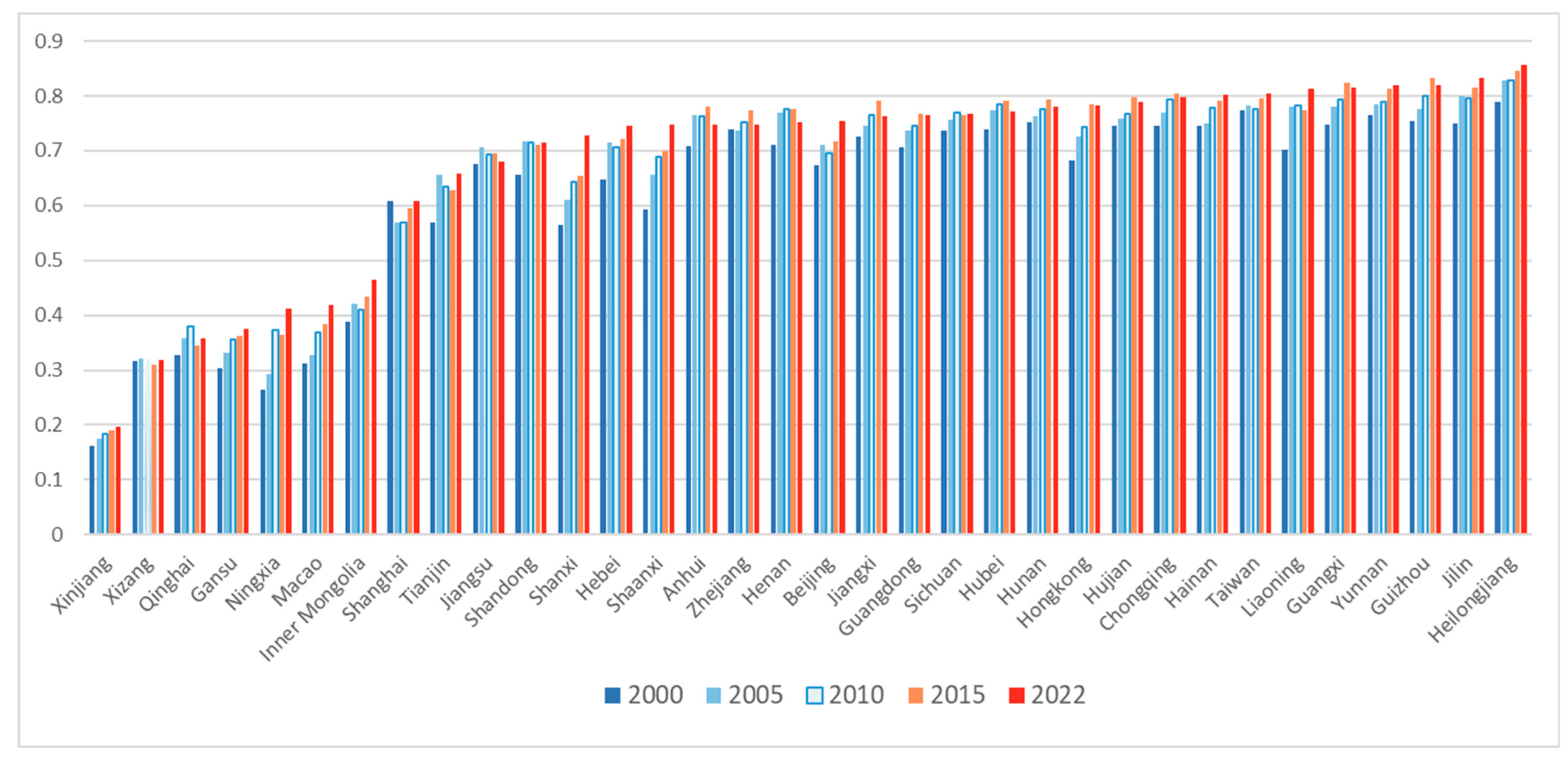
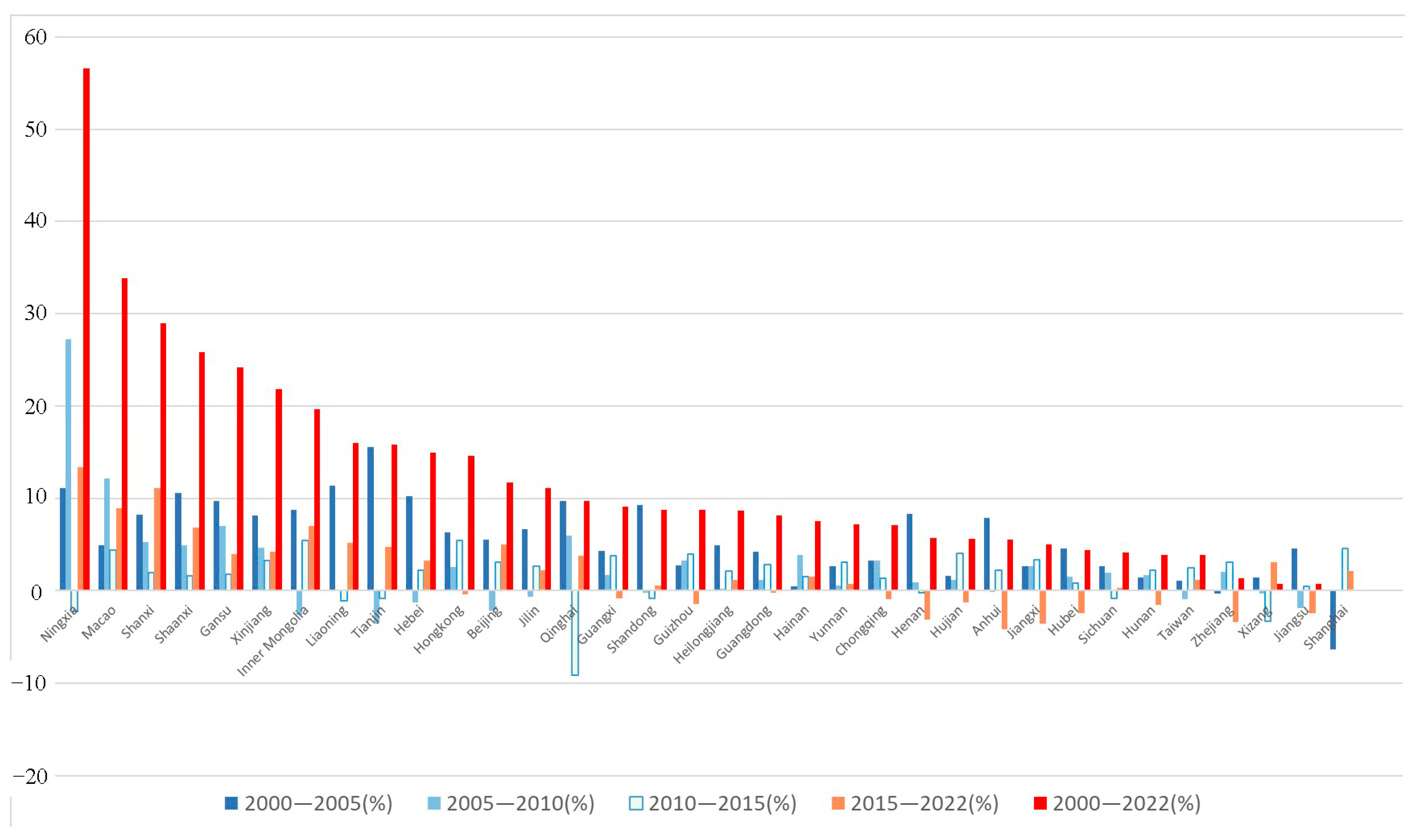

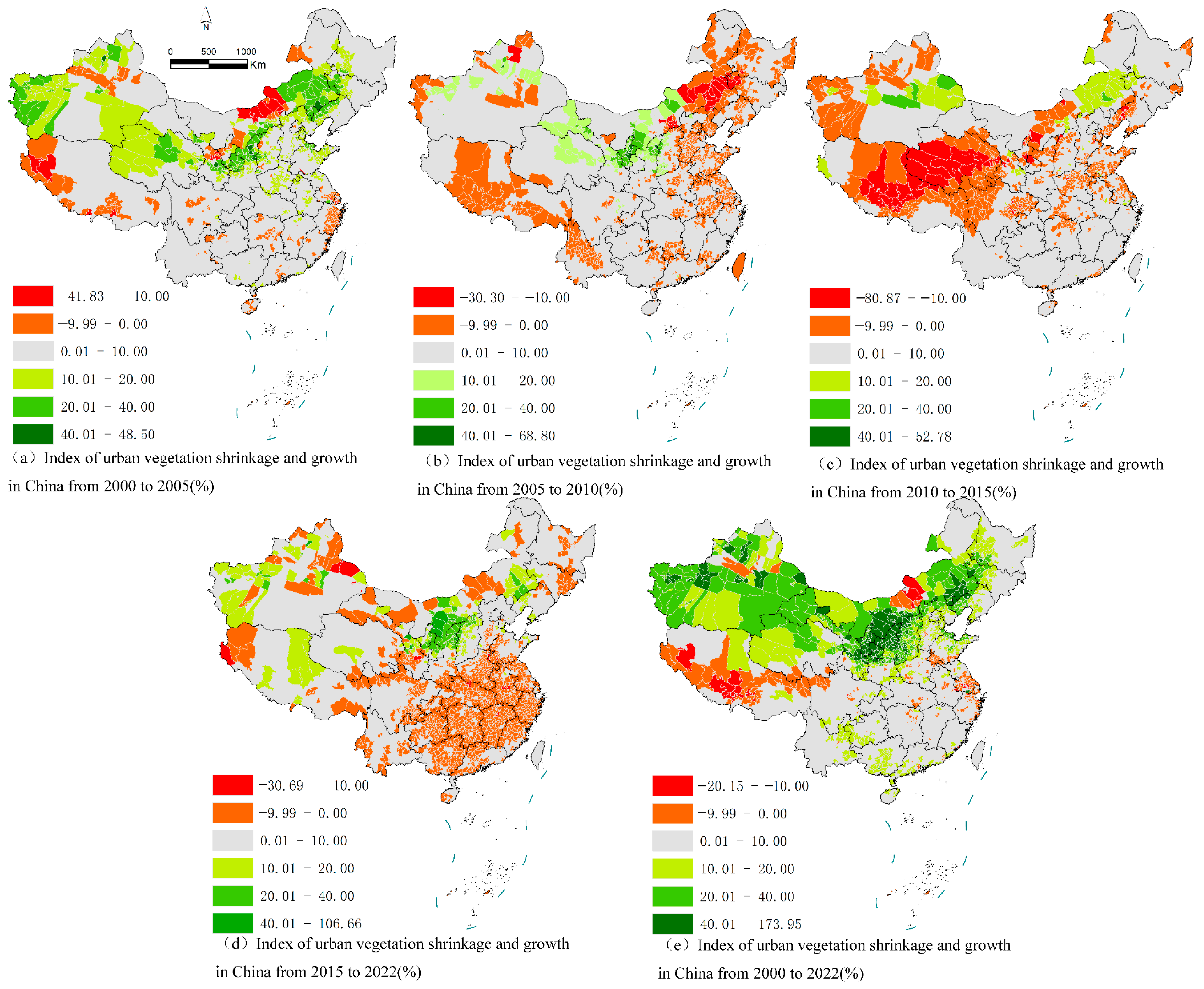

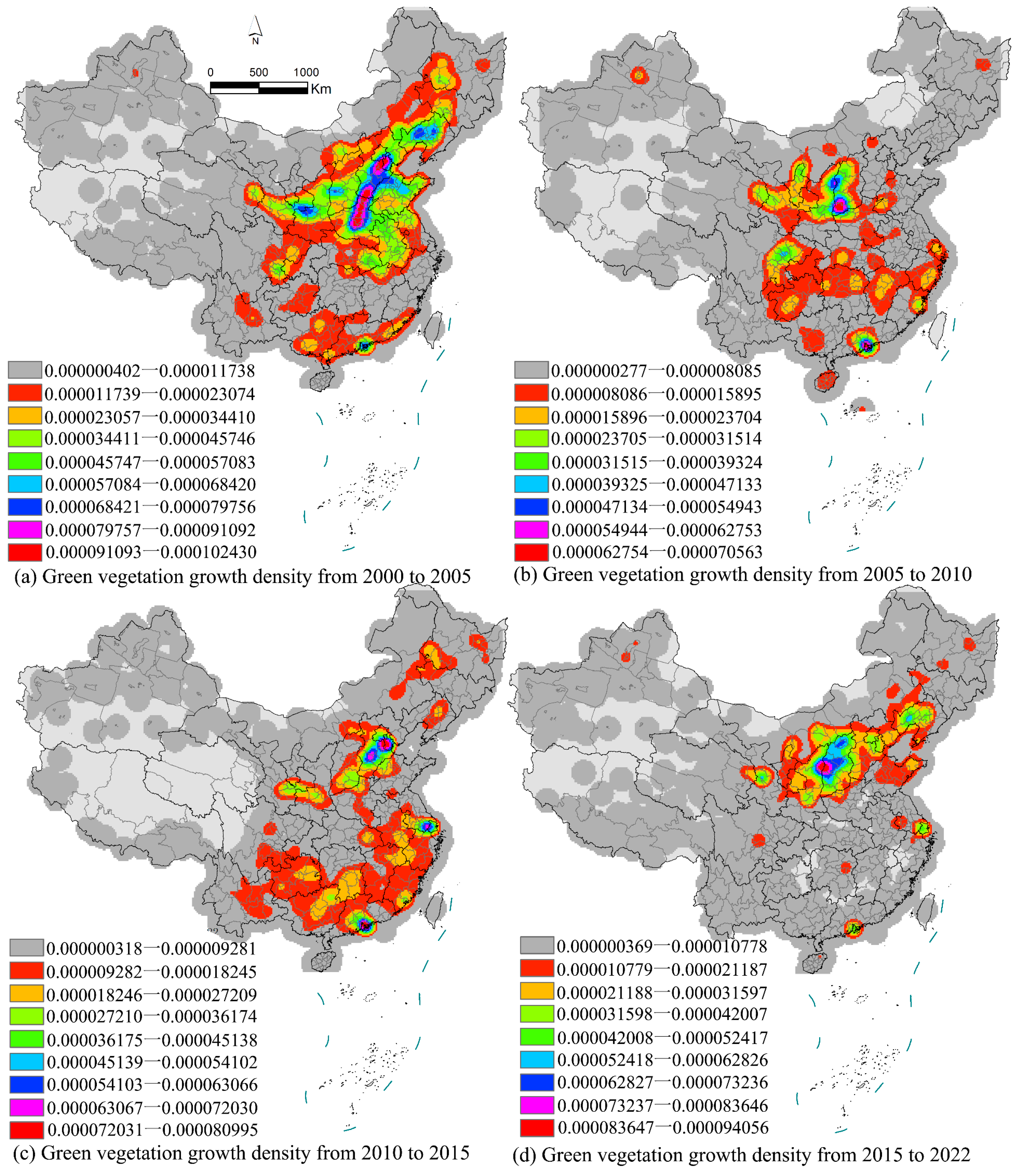

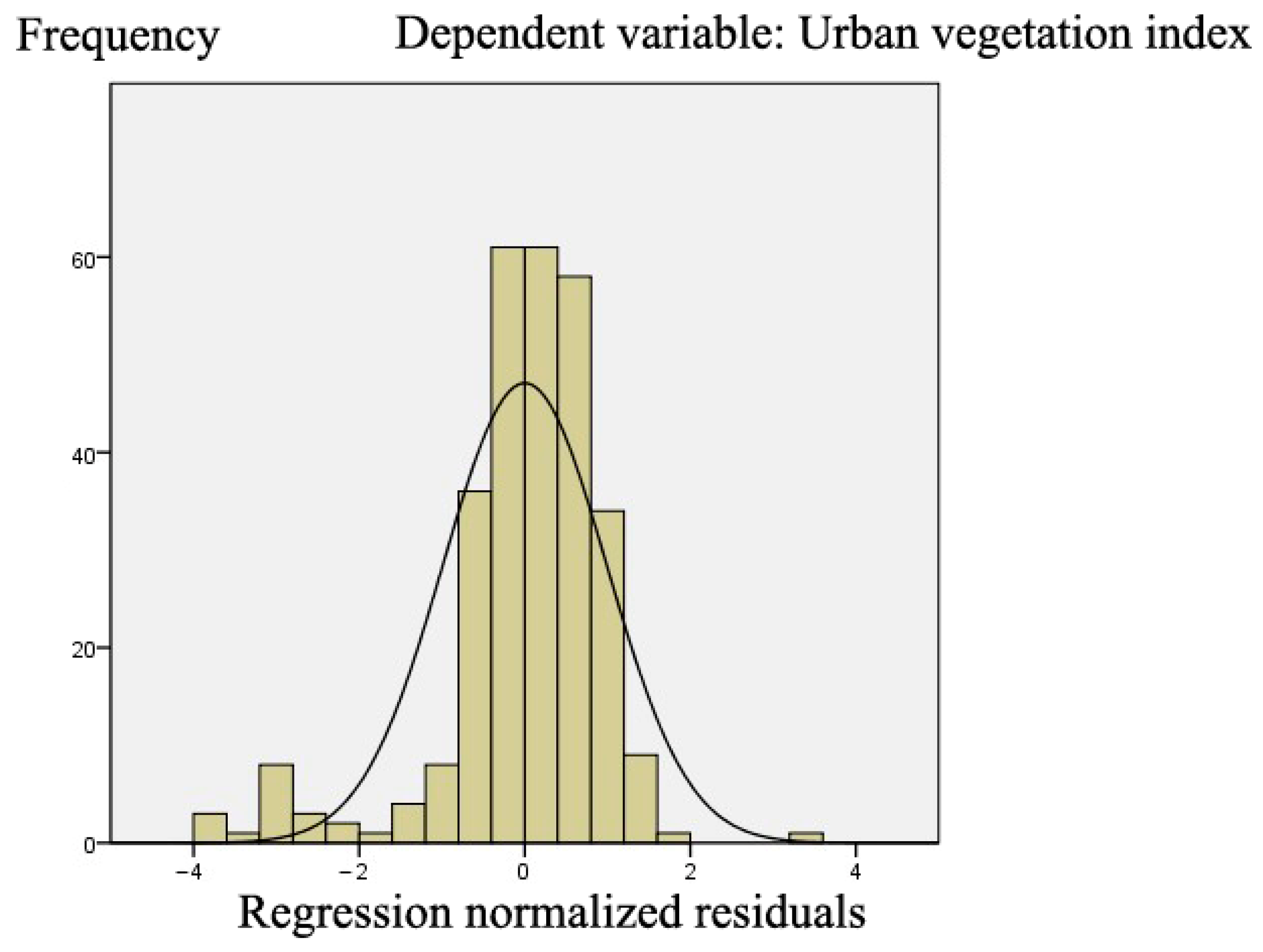
| Model | Classification of Indicators | Variable | B | T | Sig. | VIF |
|---|---|---|---|---|---|---|
| Model 1: (Dependent variable: Urban vegetation index) | (constant) | 0.77751 | 45.160 | 0.000 | ||
| Urban population | Average annual population of the city /104 people (X1) | 0.00014 | 6.036 | 0.000 | 1.300 | |
| Urban size | Land area of administrative regions in the city /104 km2 (X2) | −0.01791 | −8.287 | 0.000 | 1.094 | |
| Urban economic | Per capita GDP of the city/104 CNY (X3) | −0.01130 | −4.958 | 0.000 | 1.583 | |
| Urban agriculture | The proportion of employees in the primary industry in the city/% (X4) | 0.00518 | 3.774 | 0.000 | 1.080 | |
| Urban industrial | Industrial electricity consumption throughout the city/100 million kWh (X5) | −0.00024 | −4.152 | 0.000 | 1.968 | |
| Urban water resources | The total amount of water resources in the city/100 million cubic meters (X6) | 0.00010 | 2.739 | 0.007 | 1.066 | |
| Urban emissions | Industrial sulfur dioxide emissions in the city/104 tons (X7) | −0.02609 | −2.885 | 0.004 | 3.615 | |
| Industrial nitrogen oxide emissions in the city/104 tons (X8) | 0.02848 | 3.339 | 0.001 | 3.888 |
Disclaimer/Publisher’s Note: The statements, opinions and data contained in all publications are solely those of the individual author(s) and contributor(s) and not of MDPI and/or the editor(s). MDPI and/or the editor(s) disclaim responsibility for any injury to people or property resulting from any ideas, methods, instructions or products referred to in the content. |
© 2024 by the authors. Licensee MDPI, Basel, Switzerland. This article is an open access article distributed under the terms and conditions of the Creative Commons Attribution (CC BY) license (https://creativecommons.org/licenses/by/4.0/).
Share and Cite
Zhang, X.; Han, H.; Dai, A.; Xie, Y. The Spatiotemporal Variation Characteristics and Influencing Factors of Green Vegetation in China. Forests 2024, 15, 668. https://doi.org/10.3390/f15040668
Zhang X, Han H, Dai A, Xie Y. The Spatiotemporal Variation Characteristics and Influencing Factors of Green Vegetation in China. Forests. 2024; 15(4):668. https://doi.org/10.3390/f15040668
Chicago/Turabian StyleZhang, Xiaodong, Haoying Han, Anran Dai, and Yianli Xie. 2024. "The Spatiotemporal Variation Characteristics and Influencing Factors of Green Vegetation in China" Forests 15, no. 4: 668. https://doi.org/10.3390/f15040668
APA StyleZhang, X., Han, H., Dai, A., & Xie, Y. (2024). The Spatiotemporal Variation Characteristics and Influencing Factors of Green Vegetation in China. Forests, 15(4), 668. https://doi.org/10.3390/f15040668






